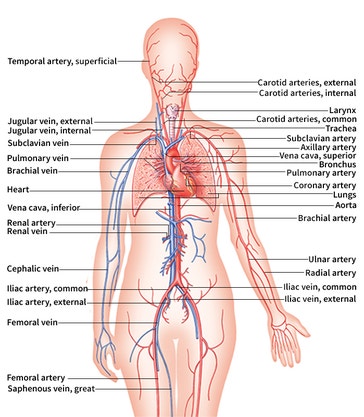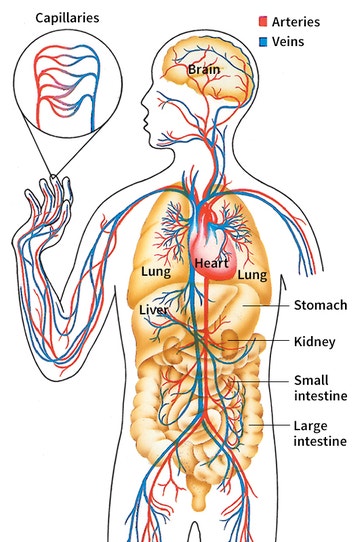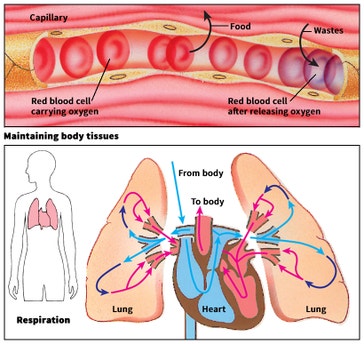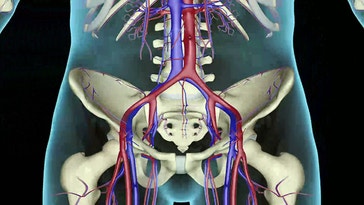오늘의 한마디
Circulatory system
Circulatory system is a network that carries blood throughout the body. All animals except the simplest kinds have some type of circulatory system.
In some invertebrates (animals without a backbone), the circulatory system consists of a simple network of tubes and hollow spaces. Other invertebrates have pumplike structures that send blood through a system of blood vessels. In human beings and other vertebrates (animals with a backbone), the circulatory system consists primarily of a pumping organ--the heart--and a network of blood vessels.
The human circulatory system supplies the cells of the body with the food and oxygen they need to survive. At the same time, it carries carbon dioxide and other wastes away from the cells. The circulatory system also helps regulate the temperature of the body and carries substances that protect the body from disease. In addition, the system transports chemical substances called hormones, which help regulate the activities of various parts of the body. This article discusses mainly the human circulatory system.
Human body: respiratory and circulatory systems
Parts of the circulatory system
The human circulatory system has three main parts: (1) the heart, (2) the blood vessels, and (3) the blood. A watery fluid called lymph, and the vessels that carry it, are sometimes considered a part of the circulatory system (see Lymphatic system).
The heart is a hollow, muscular organ that pumps blood. It consists of two pumps that lie side by side. These pumps relax when taking in blood and contract as they send out blood. The left side of the heart is a stronger pump than the right side. The stronger pump receives blood from the lungs and sends it to cells throughout the body. The weaker pump receives blood from the cells throughout the body and sends the blood to the lungs.
The blood vessels form a complicated system of connecting tubes throughout the body. There are three major types of these vessels. Arteries carry blood from the heart. Veins return blood to the heart. Capillaries are extremely tiny vessels that connect the arteries and the veins.
The blood consists chiefly of a liquid called plasma and three kinds of solid particles known as formed elements. Plasma is made up mostly of water, but it also contains proteins, minerals, and other substances. The three types of formed elements are called red blood cells, white blood cells, and platelets. Red blood cells carry oxygen and carbon dioxide throughout the body. White blood cells help protect the body from disease. Platelets release substances that enable blood to clot. Platelets thus aid in preventing the loss of blood from injured vessels.
Human circulatory system
Functions of the circulatory system
The circulatory system performs many vital functions. It plays an important role in respiration. The circulatory system is also important in nutrition, in the removal of wastes and poisons, and in several other body processes.
In respiration. The circulatory system plays a part in respiration by delivering oxygen to the cells and removing carbon dioxide from them. During this process, the blood follows two routes called the systemic circulation and the pulmonary circulation.
Some functions of the circulatory system
From the left side of the heart, blood full of oxygen is pumped into the systemic circulation. This blood leaves the heart through the aorta, the main artery of the body. A number of major arteries branch off the aorta. These arteries, in turn, branch into smaller and smaller vessels, finally emptying into the tiny capillaries. There, oxygen leaves the blood and enters the tissues through the thin capillary walls. In a similar way, carbon dioxide leaves the tissues and enters the blood. The blood, now carrying carbon dioxide, leaves the capillaries and flows through larger and larger veins. Eventually, the blood enters the right side of the heart through two large veins--the superior vena cava, which carries blood from the head and arms, and the inferior vena cava, which carries blood from the trunk and legs.
From the right side of the heart, the blood is pumped into the pulmonary circulation. Pulmonary arteries carry the blood that contains carbon dioxide to capillaries in the lungs. The carbon dioxide passes through the capillary walls into the lungs and is then exhaled. Oxygen that has been inhaled passes from the lungs into the blood in a similar way. The blood returns through the pulmonary veins to the left side of the heart and begins its journey again.
In nutrition. The circulatory system carries digested food substances to the cells of the body. These nutrients enter the bloodstream by passing through the walls of the small intestine into the capillaries. The blood then carries most of the nutrients to the liver.
The liver removes certain nutrients from the blood and stores them. It later releases the nutrients into the blood when the body needs them. The liver also changes some nutrients into substances needed by the body. Blood leaving the liver contains nutrients that the cells use in the production of energy, enzymes, and new building materials for the body.
In removal of wastes and poisons. The circulatory system helps dispose of waste products and poisons that would harm the body if they accumulated. These substances include carbon dioxide, salts, and ammonia, a by-product of the cell's use of protein.
The liver removes ammonia and other wastes, and various poisons that enter the body through the digestive system. The liver converts the wastes and poisons into water-soluble substances, which are carried by the blood to the kidneys. The kidneys filter out these and other water-soluble wastes and expel them from the body in urine.
Other functions. The circulatory system helps protect the body from disease. White blood cells engulf and destroy bacteria, viruses, and other harmful invaders. As the blood circulates, it also helps keep the body temperature stable by absorbing heat from the cells' production of energy.
If the temperature of the body begins to rise, the flow of blood into vessels in the skin increases. The heat from cells deep in the body is thus carried to the skin, from where it passes out of the body. If the temperature of the body begins to drop, the flow of blood to the skin is restricted. This action enables the body to retain as much heat as possible.
The circulatory system also carries hormones. These chemical substances affect or control the activities of various organs and tissues. Hormones are produced by the endocrine glands, including the thyroid, pituitary, adrenal, and sex glands. These glands release their hormones into the bloodstream.
Human circulatory system
Disorders of the circulatory system
The circulatory system can be damaged by disease or injury. One of the most common diseases of the system is arteriosclerosis, which results from the accumulation of fatty deposits in the arteries. Such deposits stiffen and thicken the walls of the arteries. As a result, the flow of blood is restricted. In some cases, blood clots develop in the affected vessels. Such clots may lead to a heart attack or a stroke, a condition in which the brain does not receive enough blood. Another disease, hypertension, commonly called high blood pressure, is often associated with arteriosclerosis. Hypertension makes the heart work harder and may lead to such complications as a heart attack, a stroke, or kidney failure.
Treatment of arteriosclerosis and hypertension includes medication, changes in the diet, and exercise. Doctors often prescribe drugs to lower blood pressure, strengthen the heart, and prevent blood clots. In serious cases, a surgeon may place a metal mesh stent in an artery to keep it open or perform a bypass surgery, directing the blood around one or more diseased vessels.
Other disorders result from damage or defects in the heart or blood vessels. For example, bacteria may harm or destroy the valves that control the flow of blood through the heart. Incomplete development of the heart or its blood vessels before birth may produce defects called congenital heart disorders. Many cases of damage or defects can be corrected by surgery.
The circulatory system in other animals
Vertebrates all have a closed circulatory system. In this type of system, the blood flows only in the vessels and remains separate from the fluid in the body tissues. Mammals--including human beings--and birds have a heart with two separate pumps. In these animals, the blood in the systemic and pulmonary circulations almost always remains separate. In amphibians and most reptiles, the pumps of the heart are only partly separated, and the systemic and pulmonary blood mixes together somewhat. In fish, the heart has only one pump. The pump collects the blood and sends it to the gills and then to the rest of the body.
Invertebrates have circulatory systems that range from complex to simple. Some invertebrates, such as earthworms and octopuses, have a closed circulatory system. Other invertebrates have an open circulatory system, in which the blood is only partially confined to the vessels. It fills the hollow spaces of the body as well. Animals with an open circulatory system include insects, spiders, and most shellfish.
In many invertebrates, the blood is pumped by contracting vessels or by pumping centers (contracting portions of vessels), or by both. Among insects, for example, the "heart" consists of an internal contracting vessel that extends almost the length of the back.
The simplest animals with a true circulatory system include certain kinds of worms. Earthworms, leeches, and a variety of sea worms have contracting vessels that pump the blood. A group of simpler worms, called ribbon worms or proboscis worms, have a circulatory system with no pumping centers and no contracting vessels. The movements of the animal keep the blood flowing through the body.
Robin M. Shaw, M.D., Assistant Professor of Medicine/Cardiology, University of California, San Francisco.
Shaw, R.M. (2020). Circulatory system. In World Book Student. Retrieved from https://www.worldbookonline.com/student/article?id=ar115905




